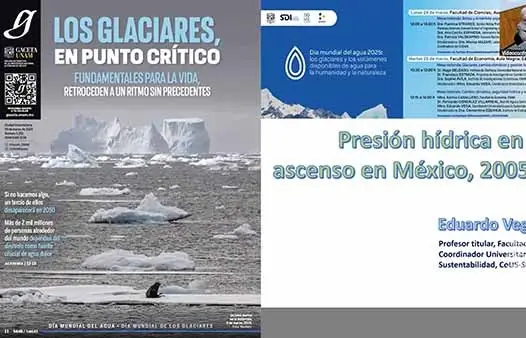The Environmental Economics professor explained that one of the components of the security index is water pressure, which is reflected in the volume of water per inhabitant relative to the national average for water management, which is declining.
During his participation in the roundtable “Glaciers and the Volumes of Water Available for Humanity and Nature,” organized by the CoUS on the occasion of World Water Day 2025, he stated that water pressure is observed in the volume for the Valley of Mexico, which increased from 191 cubic meters per inhabitant (m3/inhabitant) in 2005 to 139 m3/inhabitant in 2025, and could reach 136 m3/inhabitant in 2030.
In front of moderator Clementina Equihua Zamora of the UNAM Institute of Ecology, the former director of the Faculty of Economics (FE) explained that statistically this is expected to occur if the average volume remains constant or decreases and the population increases. We must update the diagnostics by sector, activity, territory, and water regions.
According to the expert, this is compounded by the severe drought the country is experiencing, which as of March 15 affected 32 at-risk districts with 62 percent coverage; that is, 26 metropolitan areas, including Tijuana, Mexicali, Los Cabos, Hermosillo, Ciudad Obregón, Culiacán, Durango, Chihuahua, and Monterrey, among others.
Speaking, Karina Caballero Güendulain, a FE academic, shared the progress of the Input-Output Models on Nature-Related Financial Risks project, in which she is participating with Saul Basurto (UNAM), Carlos López (Colegio de México), Serafín Martínez (World Bank), and Luis Escobar (Banco de México).
The academic coordinator of the Environmental and Ecological Economics specialization in the FE Graduate Program commented that the project uses a tool called Exploring Natural Capital Opportunities, Risks and Exposure (ENCORE), which aims to support various organizations in identifying and understanding the dependencies and impacts that economic activities have on nature.
This platform was updated in 2024 to provide information on 271 sub-industries of the International Standard Classification, with 25 ecosystem services and impacts in 13 areas directly related to water pollution, water extraction, greenhouse gas emissions, and soil contamination.
Using this tool, Caballero Güendulain and her team review multiple supply chains and the impacts they will have on them, for example, reduced water availability, as is the case with corn, whose price will be affected, as will the country’s food chain.
Rafael Val Segura, executive coordinator of the Water Management, Use, and Reuse Program at UNAM, presented progress on the Water Security Index for Latin America and the Caribbean.
The report reviews water security records from the last eight years, with the region starting with a score of 586 in 2015 and increasing to 650 in 2022. However, performance is still low, as the maximum is 1,000 points. In other words, improvements have been made, but more remains to be done to achieve the Sustainable Development Goals by 2030.
Val Segura explained that, based on the country-by-country water security indices, Chile, Brazil, Panama, and Uruguay have the highest levels in this area; while Mexico, Argentina, Peru, and Cuba have the lowest.
If water security results are compared with GDP, he added, nations with high levels of security (Panama, Brazil, Uruguay, and Chile) also have high GDP levels because they have worked to strengthen this area.
He added: the region is moving slowly. We won’t get there by 2030; significant differences persist among the nations in the region, and more investment is required, because greater growth means greater water security.
a.jpg)
Source: dgcs.unam




